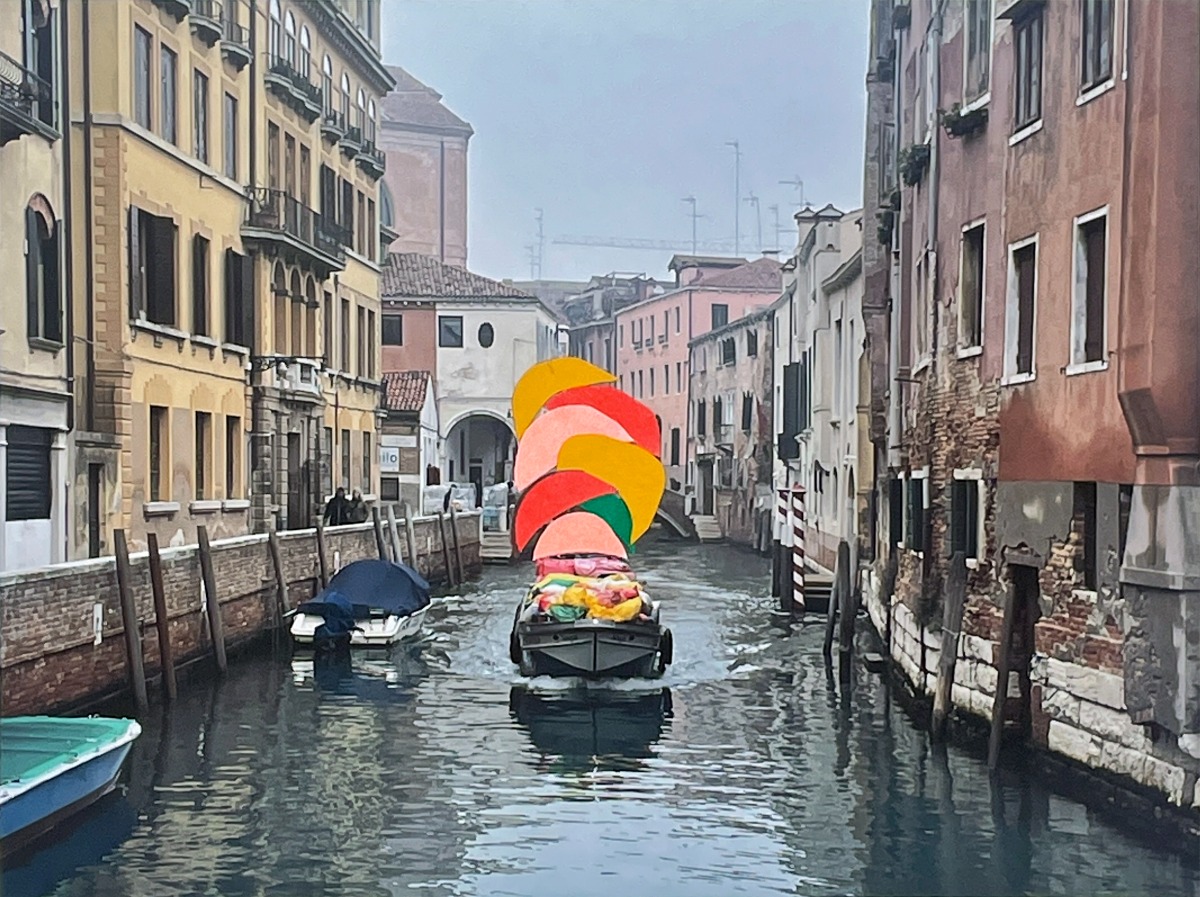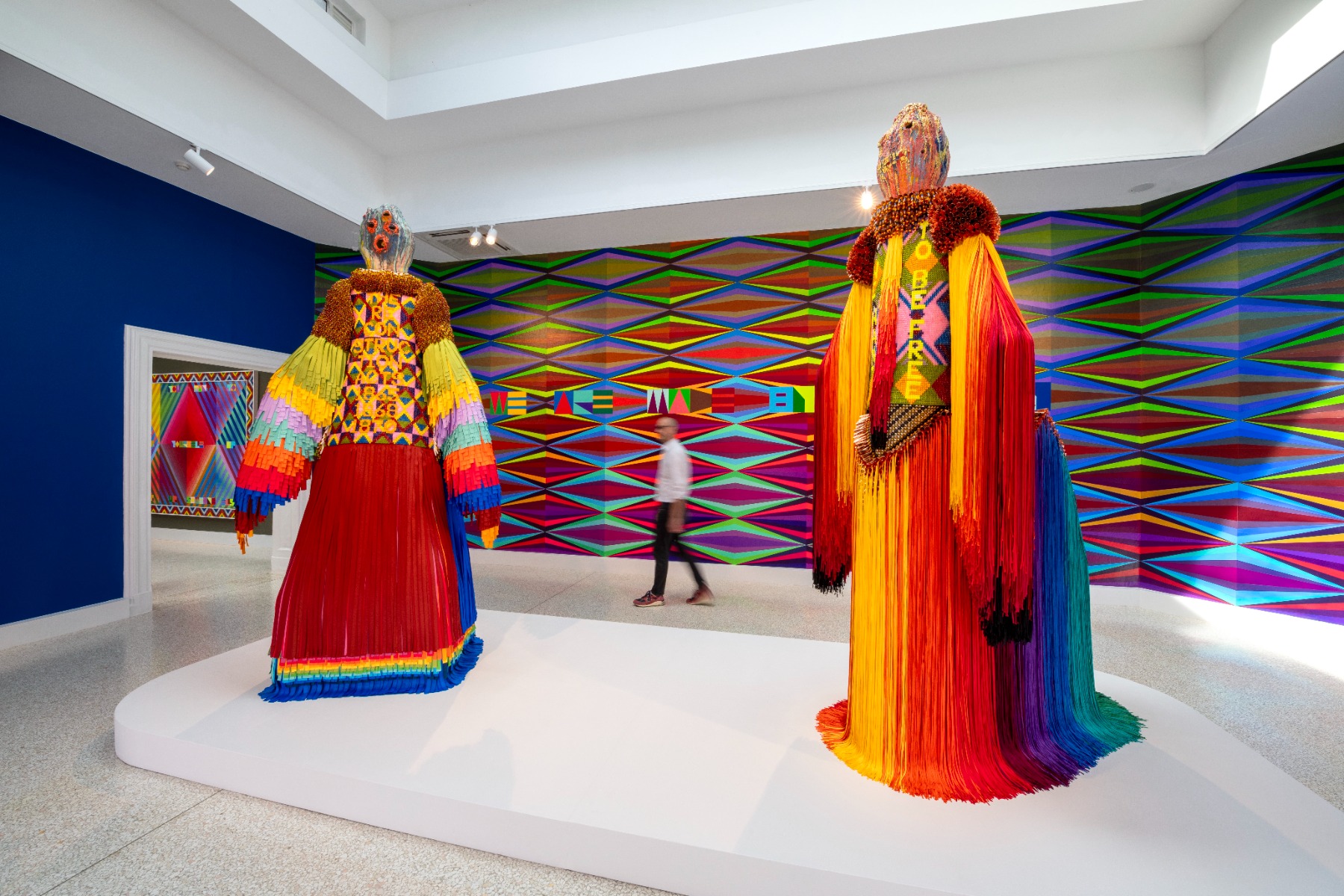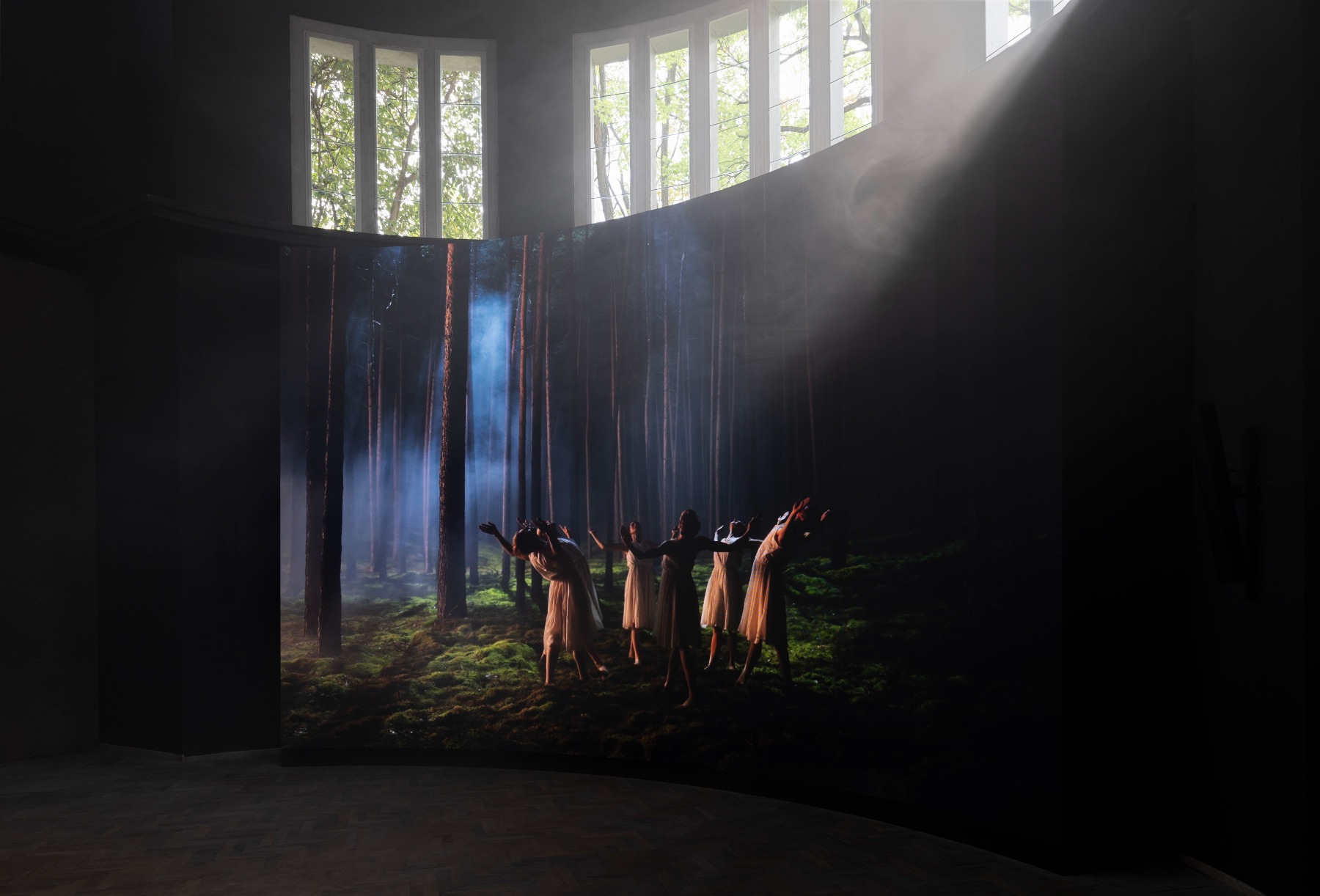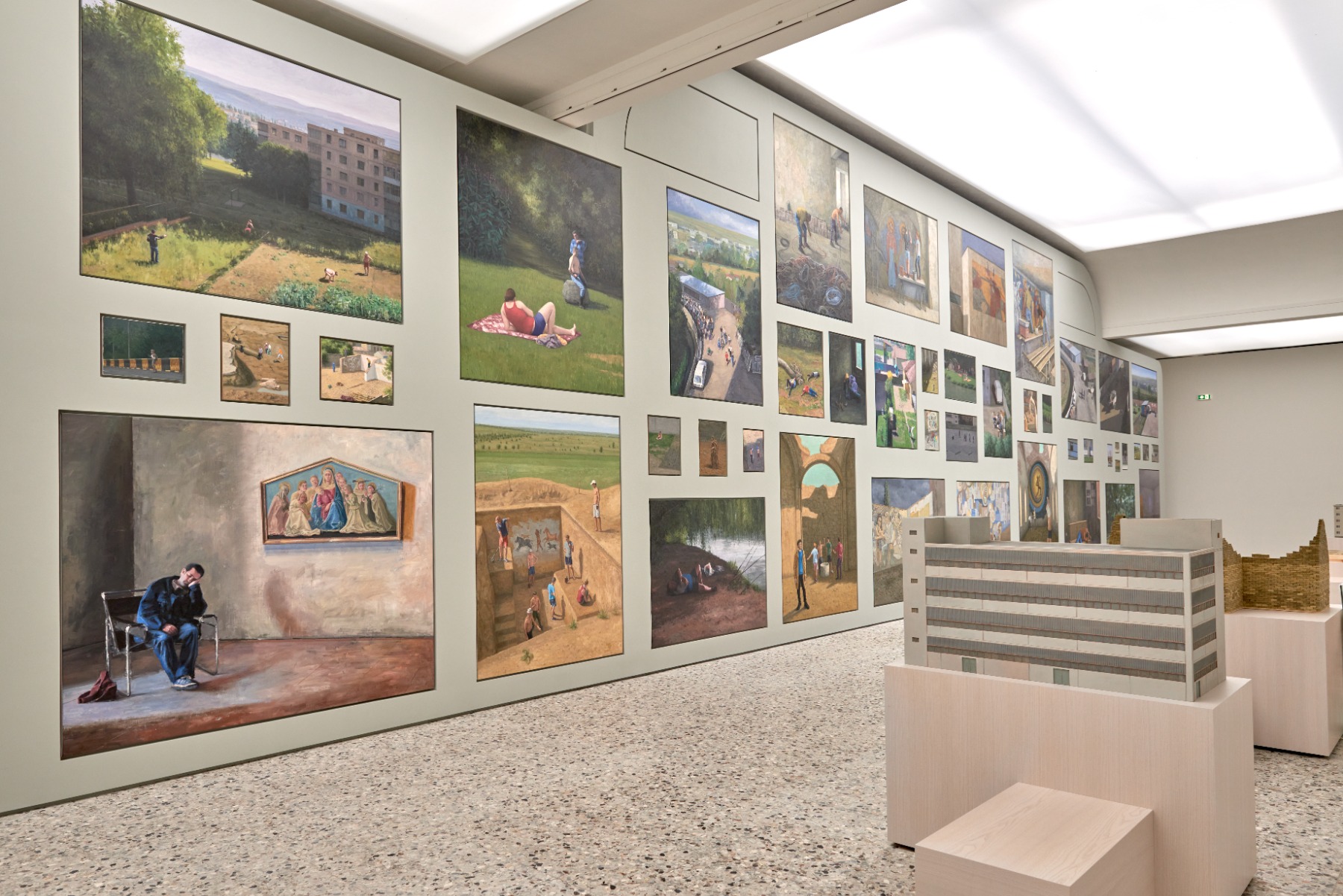
Knowing Where You Are
Selections from the Biennale’s national pavilions
The national pavilions offer, more than the Biennale’s main exhibition, the excitement of seeing a cross section of contemporary art, layered in conception and with relevance for what is happening now. The various presentations are not necessarily connected, as every country had its own path to Venice, selecting one or multiple artists. Therefore, it is hard to discuss this part of the Biennale as one exhibition. However, what unites all exhibitors is their platform on the global stage provided by Venice. The question of how artists approach this opportunity and whether they can handle it, becomes part of the quality of the work. Below are ten pavilions that made a lasting impression on the author, while overt political commentaries are avoided and instead imaginative approaches are presented, tailored to the specific site of the building, the city or the Biennale.
USA Pavilion / Jeffrey Gibson. the space in which to place me
USA
Though not required, some countries appear to have aligned their choice of artist with the main theme of the Biennale, “Foreigners Everywhere”. Notable in this respect is the USA, which selected indigenous artist Jeffrey Gibson to represent the nation. Gibson is no stranger to the scene, having expressed his desire for “long-term evidence that Native people exist, are present, and contribute” during his participation in the 2019 Whitney Biennial. Through his beaded sculptures, garments, and paintings, Gibson highlights craftsmanship while paying homage to indigenous concepts and motifs, blending them with various inspirations such as decoration, psychedelia, and modern design. He manages to create the feeling that his work is rooted in the contemporary world even though what he presents is not a side of the USA that we get to see very often.
German Pavilion / Yael Bartana. Light to the Nations. Photo: Andrea Rossetti
Germany
Germany chose two artists, Ersan Mondtag and Yael Bartana, for the pavilion who both make a firm appearance, albeit without their contributions complementing each other. I found Bartana’s Light to the Nations to be the most captivating. The centerpiece, Farewell, is a 15-minute-long science-fiction film depicting people performing a ritual dance in nature before they leave Earth in a spaceship to save themselves and humanity. This Generation Ship has large round cylinders, each representing a different sphere of life such as learning, living and healing. Its form is based on the sephirot diagram, the main image of the Kabbalah, the Jewish mystic tradition. The film presents messianic narrative that, as is often the case in Bartana’s work, teeters on the brink of Romantic kitsch while closely resembling a religious movement in its aspirations and aesthetics. Her work exudes controlled pathos, grand gestures, and technological precision. The urgency of the science-fiction narrative lies in the question that may easily arise when reading the news today: Isn’t it time to consider an escape? Or perhaps more profoundly: Is escape even still possible?
Canadian Pavilion / Kapwani Kiwanga. Trinket
Canada
One profound quality that comes out in the Canadian pavilion is lightness. This does not mean that Kapwani Kiwanga’s thematic interests are without weight. Rather, the Paris-based artist presents forms that are less obvious and less focused on narrative. Seventy percent of Kiwanga’s art is research based, and in this case, the mapping of Venice as a city of merchants lies underneath the choice of materials. The principal material in the installation is conterie, also known as seed beads. Conterie were dispersed from Murano in the Venetian archipelago and found their way to various material cultures throughout the world. Historically employed as both currency and items of exchange, these tiny glass units are used to transform the pavilion, covering both the inside and outside walls. Whereas the interest behind the material might refer to power or trade relations, on the inside, the language of presentation is abstract. One can sense, through the placement of objects, the temperature of different colors and the way the inside and outside of the glass pavilion are connected, that Kiwanga’s attention was directed toward creating a balance of forces.
Greece Pavilion / Kostas Chaikalis, Thanasis Deligiannis, Elia Kalogianni, Yorgos Kyvernitis, Yannis Michalopoulos, Fotis Sagonas. Dryland 
Greece
For the Greek pavilion, Thanasis Deligiannis and Yannis Michalopoulos collaborated with four other artists to conceive a work centered around a traditional village festival known as the panaghíria. The focus extends from the festivities to life in rural communities more broadly. In the center of the pavilion is a giant hydraulic machine like one used in the heartland of Greece for irrigating the land. This machine regulates the intervals at which it releases water through pressure. Water scarcity in some regions, coupled with recent flooding events affecting communities, has turned the management of water into a political issue. The yearly village festivals underscore the continuity of life and community spirit through dancing, feasting, processions, and fireworks. However, as the artists observe, hospitality is not extended to everyone, and traditional lifestyles clash with current views on gender and identity. Rather than offering a complete narrative or documentary, the collective work presents a cryptic and sometimes poetic image of a part of Greek reality that remains largely invisible to outsiders.
Romanian Pavilion / Șerban Savu and Atelier Brenda (Nana Esi, Sophie Keij). What Work Is. Photos: Marius Popuţ
Romania
What Work Is, the solo exhibition of Serban Savu at the Romanian pavilion, stands out as a monumental and precise presentation. A wall with paintings merges into one colossal piece offering a retrospective of the artist’s output over the past fifteen years. The collection comprises both smaller and larger paintings, many of which feature painting itself as the subject matter, or the question of the extent to which painting belongs to the category of labor and its place in society. There are scenes of people restoring a painting in a church, of someone sleeping next to an image of the Madonna, and of the hall of a station where individuals are waiting on benches beneath a giant wall painting. Executed in a figuratively precise style, the works initially appear to adhere to a traditional aesthetic. However, upon closer inspection, they reveal an ironic or critical dialogue with the socialist realism prevalent in many Eastern European countries, evident in public buildings. Absurdity, fatigue, and a solitary atmosphere charge the works and offer a range of responses to work and leisure in daily life.
Italian Pavilion / Massimo Bartolini. Due qui / To Hear. Photo: © Agostino Osio / Alto Piano
Italy
Μany countries lack dedicated buildings and are instead nestled within the seemingly endless succession of spaces at the Arsenale. At the distant end lies the Italian pavilion, where Massimo Bartolino’s installation, Due qui / To Hear, exemplifies finding a personal frequency to engage with an audience, unaffected by the political debates on art and identity elsewhere in the Biennale. Bartolino’s contribution is primarily acoustic, although the visual elements support and enhance the auditory experience. In a vast hall, a system of tubes resembling scaffolding has turned into an organ and creates a sonic environment. At the heart of this structure sits a circular basin with moving water, drawing visitors to pause and reflect. It hints at being a central source, though its exact nature remains ambiguous. Taking the time to engage with the sound piece feels like tuning in to a foundational tone resonating within one’s own body. Once attuned to this sound, the distractions of the Biennale’s spectacle seem less overwhelming. Bartolino’s installation offers a contemplation on how art can provide an experience of grounding oneself, not by looking outward, but by listening inward.
Latvian Pavilion. Amanda Ziemele. O day and night, but this is wondrous strange... and therefore as a stranger give it welcome. Photo: Līga Spunde
Latvia
Another pavilion with works that do not present an obvious narrative is Latvia’s, also in the Arsenale. Amanda Ziemele’s large colored panels, spread across the floor and suspended from the ceiling, evoke various associations—perhaps a flower, a shelter, a wing or a wave —but they never fully conform to any single description. A work the artist made in 2023 is called Unfortunately Untranslatable, and that may as well apply to the elements that are brought together here. The artist seems to enjoy the space where language can no longer be relied upon. Her paintings, which are at the same time objects, do not really have a name that fits. They are bold in their presence and loud in terms of color. Yet, some individuality appears in their forms, and they sometimes behave like beings of some sort, with more fragile aspects. One seems tired, part of it wanting to fall down; another creates an opening and looks rather inviting; a third one makes a circular gesture, as if holding itself. The pieces seem like actors in the space, yet they could also be considered props, making the visitor the real actor.
Albanian Pavilion / Iva Lulashi. Love as a glass of water
Albania
In the Albanian pavilion, Iva Lulashi presents her works on a 1:1 scale model of her apartment in Milan, recreated within the Arsenale. The walls are arranged accordingly, the furniture and windows left out, providing a white-cube setting for a series of paintings united under the overarching theme Love as a Glass of Water. The figurative paintings show scenes of desire, the moment before or after making love, and other experiences, from a female perspective. Part of the works are based on erotic or pornographic footage that is then modified during the painting process. The domestic floor plan delivers a shelter where the works can have the intimacy and focus that the artist wishes to be the context for her work. At times this creates the feeling of looking at something you are not supposed to see, as with the painting of two female figures and a male, all naked and looking down, presented in a narrow tiled room that at the artist’s home must be the bathroom. A perfect example of how the presentation is part of the painting’s meaning.
Croatian pavilion / Vlatka Horvat. By the Means at Hand
Croatia
The Croatian pavilion stands out as one of the most endearing spaces at the Biennale, serving not only as an exhibition venue but also as an artist studio for Vlatka Horvat, who invites artists from around the world to contribute small art pieces. However, these contributions come with a unique condition: they must be personally couriered by someone planning to travel to Venice, eliminating the need for additional shipping, and highlighting the environmental concerns associated with large-scale events like the Biennale. The works received by Horvat are displayed temporarily alongside her own pieces inspired by walks through the city where she captures memorable sights and moments and reimagines them through collage and drawing on photography. What Horvat achieves is a space of concentration, where looking at works and discussing them happen on an intimate, almost domestic scale. This contrasts in a positive sense with the spectacle of the Biennale, with its long queues and dense exhibition areas, plus the loud drums of major galleries hosting so-called collateral events across the city. Here, art-making takes on a more personal and improvised dimension, emphasizing the interconnectedness of artists. Moreover, the rotating display of works includes contributions from artists not officially representing a country.
Estonian Pavilion. Edith Karlson. Hora Lupi/The Hour of the Wolf
Estonia
One of my favorite pavilions is found away from the crowds, in the Chiesa di Santa Maria delle Penitenti in Venice’s Cannaregio neighborhood. Representing Estonia, Edith Karlson chose this location to populate with her eerie yet captivating scultped creatures —giant fighters, mermaids, a snake, weeping women, double-headed cats, and ceramic skulls. In harmony with the abandoned church, the somewhat unsettling yet beautiful creatures evoke, according to the title, The Hour of the Wolf, referring to the time between the darkest part of night and dawn when inexplicable occurrences unfold, and when apparently most babies are born. Themes of birth, death, and loss permeate the exhibition. The artist described it as ‘a mixture of fear, excitement, unknown and inevitability, sort of like the moment we’re living now.’ The more time spent in the church, the more apparent it becomes that she truly looked at and "listened" to the location, harnessing its full potential while keeping a balance between her own artistic presence and the environment that creates quite some content of its own.
While strolling through the pavilions, it is tempting to ask who would most deserve the Golden Lion for the best national participation. While the official jury chose Archie Moore of Australia, my vote would go to Edith Karlson of Estonia for making a work that is autonomous in conception, rich and free in imagination, and at the same time in tune with the specifics of the site and the city. Yet other pavilions like Croatia and Romania should also earn a place on the podium. Ultimately, the Biennale is not merely a competition with a winner, but rather an opportunity to meet the artistic mentalities of today. It makes the viewer consider which qualities count, in their relation to this specific moment. In an era where a large-scale event like the Biennale may be superfluous or even questioned, my favorite pavilions stand out for their fine sense of scale, proportion, and the ability to create a setting of their own. They are made by artists with a clear awareness of where they are.